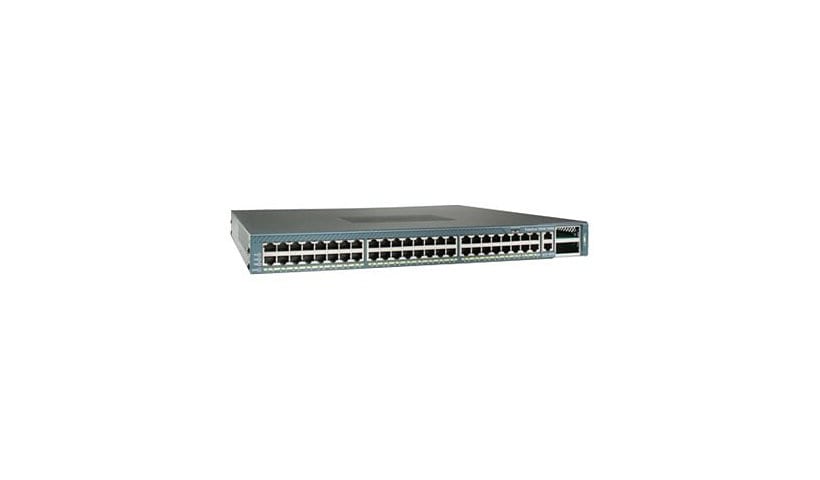
Quick tech specs
- port 10/100/1000BASE-T Gigabit Ethernet managed rackmountable switch with 2 wire-speed 10 Gigabit Ethernet uplinks and Standard Multilayer Image (SMI) and one AC power supply
Know your gear
Cisco Systems® announces the Cisco® Catalyst® 4948-10GE, a low-latency, 48-port 10/100/1000, 1-rack unit (RU), fixed-configuration switch with 2 wire-speed 10 Gigabit Ethernet uplinks for rack-optimized server switching applications. The Cisco Catalyst 4948-10GE offers exceptional performance and reliability for Layer 2 and Layer 3 server switching deployments for enterprise customers.
The Cisco Catalyst 4948-10GE delivers wire-speed throughput with low latency for data-intensive applications using a 136Gbps switching fabric with a 102-million packets per second (mpps) forwarding rate in hardware for Layer 2-4 traffic. High-performance switching is delivered regardless of the number of route entries or Layer 3 and 4 services enabled. Hardware-based Cisco Express Forwarding routing architecture allows for increased scalability and performance. X2 10 Gigabit Ethernet optics provide 20 Gigabit Ethernet wire-speed uplinks for maximum throughput of traffic.
Primary hardware features include:
• Wire-speed performance for 10/100/1000 connectivity and wire-speed 10 Gigabit Ethernet uplinks
–136-Gbps switching fabric with 102-Mpps forwarding rate for Layer 2 through 4
• Power-supply redundancy for nonstop operation
–1+1 redundant hot-swappable internal AC or DC power supplies
• Robust Security
–Prevention of man-in-the-middle and IP-spoofing attacks
–Access control lists (ACL)
–Secure Shell (SSH) Protocol versions 1 and 2
–Simple Network Management Protocol Version 3 (SNMPv3) for secure remote access and network management
• Comprehensive management
–Dedicated 10/100 console port and dedicated 10/100 management port
–Remote in-band management through SNMP
Software Features:
Per-port, per-VLAN quality of service (QoS) offers differentiated quality of services to individual VLANs on a trunk or access port. It allows service providers to rate-limit individual VLAN-based services on each trunk port to a business or a residence. Per-port, per-VLAN service policy can be separately applied to either ingress or egress traffic.
Trunk-port security extends the port security to trunk ports on a per-VLAN basis. It restricts the allowed MAC addresses or the maximum number of MAC addresses to individual VLANs on a trunk port. Trunk-port security helps service providers to block the access from a station with a different MAC address than the ones specified for that VLAN on that trunk port. When a trunk-port security violation occurs, the trunk port is either shut down, or an SNMP trap is generated. Trunk-port security is also supported on private VLAN trunk ports.
The 802.1x private VLAN (PVLAN) assignment feature extends 802.1x VLAN assignment to the PVLAN environment for Layer 2 isolation. When a port is configured as a PVLAN host port, 802.1x PVLAN assignment authorizes a user to a specified secondary PVLAN. This feature can not be enabled concurrently on a port with a voice VLAN.
The 802.1x private guest VLAN feature extends 802.1x guest VLAN to the PVLAN environment for Layer 2 isolation. When a port is configured as a PVLAN host port, 802.1x private guest VLAN offers limited network access through a guest secondary PVLAN to users without a 802.1x supplicant.
The 802.1x RADIUS-supplied timeout feature allows a switch to determine the duration of a session and the action to take when the session's timer expires. Based on the value specified by a RADIUS server, a Cisco Catalyst 4500 Series Switch can reauthenticate a host when the timer expires. This offers a standard mechanism for periodic 802.1x reauthentication based on a configurable timer.
The Cisco Catalyst 4948-10GE delivers wire-speed throughput with low latency for data-intensive applications using a 136Gbps switching fabric with a 102-million packets per second (mpps) forwarding rate in hardware for Layer 2-4 traffic. High-performance switching is delivered regardless of the number of route entries or Layer 3 and 4 services enabled. Hardware-based Cisco Express Forwarding routing architecture allows for increased scalability and performance. X2 10 Gigabit Ethernet optics provide 20 Gigabit Ethernet wire-speed uplinks for maximum throughput of traffic.
Primary hardware features include:
• Wire-speed performance for 10/100/1000 connectivity and wire-speed 10 Gigabit Ethernet uplinks
–136-Gbps switching fabric with 102-Mpps forwarding rate for Layer 2 through 4
• Power-supply redundancy for nonstop operation
–1+1 redundant hot-swappable internal AC or DC power supplies
• Robust Security
–Prevention of man-in-the-middle and IP-spoofing attacks
–Access control lists (ACL)
–Secure Shell (SSH) Protocol versions 1 and 2
–Simple Network Management Protocol Version 3 (SNMPv3) for secure remote access and network management
• Comprehensive management
–Dedicated 10/100 console port and dedicated 10/100 management port
–Remote in-band management through SNMP
Software Features:
Per-port, per-VLAN quality of service (QoS) offers differentiated quality of services to individual VLANs on a trunk or access port. It allows service providers to rate-limit individual VLAN-based services on each trunk port to a business or a residence. Per-port, per-VLAN service policy can be separately applied to either ingress or egress traffic.
Trunk-port security extends the port security to trunk ports on a per-VLAN basis. It restricts the allowed MAC addresses or the maximum number of MAC addresses to individual VLANs on a trunk port. Trunk-port security helps service providers to block the access from a station with a different MAC address than the ones specified for that VLAN on that trunk port. When a trunk-port security violation occurs, the trunk port is either shut down, or an SNMP trap is generated. Trunk-port security is also supported on private VLAN trunk ports.
The 802.1x private VLAN (PVLAN) assignment feature extends 802.1x VLAN assignment to the PVLAN environment for Layer 2 isolation. When a port is configured as a PVLAN host port, 802.1x PVLAN assignment authorizes a user to a specified secondary PVLAN. This feature can not be enabled concurrently on a port with a voice VLAN.
The 802.1x private guest VLAN feature extends 802.1x guest VLAN to the PVLAN environment for Layer 2 isolation. When a port is configured as a PVLAN host port, 802.1x private guest VLAN offers limited network access through a guest secondary PVLAN to users without a 802.1x supplicant.
The 802.1x RADIUS-supplied timeout feature allows a switch to determine the duration of a session and the action to take when the session's timer expires. Based on the value specified by a RADIUS server, a Cisco Catalyst 4500 Series Switch can reauthenticate a host when the timer expires. This offers a standard mechanism for periodic 802.1x reauthentication based on a configurable timer.
